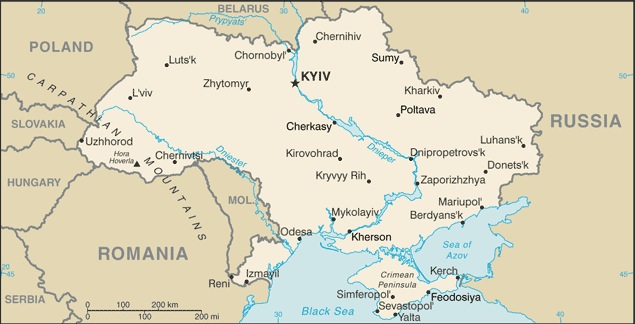Poland suddenly reappeared in 1919, 120 years after it vanished from the map of Europe, sowing confusion at the Versailles Peace Conference as the great powers tried to heal the wounds of World War I. The British questioned the legitimacy of the new Polish State and the French were suspicious of Polish ambitions. Frustrated with allied reluctance to help Poland, Josef Pilsudski, Poland’s new leader told a French journalist:
“The great evil afflicting our country (Poland) is the fact that the Allies have no clear and definite program. We are left to face this big Eastern question all alone, because Europe does not know what it wants…We Poles are next-door neighbors to Russia… We have got to decide ‘yes’ or ‘no,’ peace or war. We cannot wait any longer.”
Poland refused to die. Marshal Pilsudski’s Polish forces counterattacked the next year, annihilating the Red Army and shattering Trotsky’s dream of marching over “Poland’s corpse” into Germany.
What are the parallels with Ukraine? Like Poland in 1920, Ukraine also refuses to die. Americans must engage in an authentic, unbiased appraisal of U.S. and allied military capabilities. Put more bluntly, in Putin’s next crisis, Washington and its allies may be compelled to put up or shut up. Consider the following:
Putin commands the Russian Armed Forces and its surrogates in Eastern Ukraine through the Stavka, the High Command of the Russian Armed Forces. The Stavka is staffed by talented officers that have risen through a highly selective professional general staff system. The High Command imposes absolute unity of command on all branches of the Russian armed forces. In contrast, the Joint Staff in Washington is a feckless organization with no command authority. The Joint Chiefs of Staff (JCS) are a committee of Service Chiefs focused on “service equities.”
Russian electronic warfare and cyber capabilities can interfere with many of America’s high precision weapons, GPS-based navigation and guidance systems, as well as our RF-based networking between tactical platforms and operational commands. Combine these problems with the practice of last minute lash-ups of Army, Marine, Air Force and Navy headquarters, and the scene is set for disaster.
Russian air defense technology is capable of identifying, tracking and potentially destroying every manned and unmanned aircraft in the U.S. inventory from AH-64 attack helicopters and A-10 Warthogs to the B-2 Bomber. In a contest with Russian forces in Ukraine, a confrontation could easily resemble the 1973 Egyptian-Israeli War along the Suez Canal. The reach and impact of American aerospace power would be severely limited. Given America’s history of predictable, sequential operations — first air, then, ground offensives — the probability of U.S. military paralysis early in a conflict with the Russians is high.
But Russian forces boast other advantages. They have a short commute to the battles from their bases in southern Russia. U.S. and allied ground forces would have to move at least 400 miles from the Polish border, or roughly the distance from Kuwait City to Baghdad, just to reach the staging areas in the Dnieper River valley. It is very doubtful that Mr. Putin would mimic Saddam Hussein, and simply do nothing while U.S. and allied forces built up and then move hundreds of miles of open terrain to attack him.
Russia is waging war in the Donets Basin or Donbass with tank and armored infantry formations heavily reinforced with rocket artillery and a host of strike systems, as well as, manned and unmanned aircraft. Under the Stavka’s direction, Russian forces are integrating the maneuver of mobile armored formations with the application of massive strikes against the opposing Ukrainian forces.
If the U.S. Army’s XVIII Airborne Corps and/or the Marine Corps, the French and British rapid deployment forces or the German Air-Landing Brigade were deployed to fight in the Donbass, their survival in contact with these Russian ground forces would be counted in hours, if not minutes. No amount of American or allied intelligence, surveillance and reconnaissance, (ISR) let alone strike from aerospace and naval forces can compensate for this weakness. But, today, these light forces constitute the majority of American and allied ground forces.
How meaningful and enduring the recently announced ceasefire between Kiev and Moscow will turn out to be is not known. But Putin’s gushing nostalgia for the Soviet Union of his youth suggests he thinks much like Stalin and would push Russia’s borders westward over Ukraine’s shattered remains.
The central question for America’s elected leaders is: what should Congress do?
Washington must not risk a future confrontation with Moscow, or for that matter, any great power, with ground maneuver forces that are organized, trained and equipped to defeat relatively lightly armed and equipped Arabs, Afghans and Africans.
First, the nation needs standing Joint Force headquarters in the regional unified commands. These are not JTFs thrown together at the last minute. They are staffed and equipped to rapidly integrate capabilities across service lines, and assimilate ground maneuver with the devastating, long-range precision strikes of aerospace and naval power in future conflicts.
Second, Congress must end the U.S. Army’s penchant for squandering billions of dollars on failed modernization programs, programs presented as “transformational,” but lacking an integrative strategy, a joint warfighting purpose and a realistic tactical foundation. If Army airborne, air-mobile and Marine Corps amphibious forces are useful only in “permissive environments” against weak opponents in the developing world, then scarce defense resources should be diverted from light forces into the development of new ground maneuver forces with modern mobile armored firepower. We need mobile ground forces that can take hits, fight and win against capable opponents like Russia and other great powers, not forces designed to police and combat hapless Arabs, Afghans and Africans.
Putin is restoring Soviet norms in Moscow’s foreign and defense policy. It’s why Congress should heed Józef Pilsudski’s “lesson learned” from dealing with the Russians: “When she (Russia) is weak she is ready to promise anything, but she is equally ready to break those promises the moment she feels strong enough to do so.”
Douglas Macgregor, a member of the Breaking Defense Board of Contributors is executive vice president of Burke-Macgregor Group, LLC, a defense consulting firm in Reston, Virginia. His newest book, Margin of Victory, will appear in the fall of 2015.
Questions hang over UK’s new, ambitious defense spending plan: Analysts
Such is the scale of British Army acquisition problems alone that they could not be resolved if the UK moved to a long term spending settlement of even 4 percent GDP, an expert told British lawmakers.




























